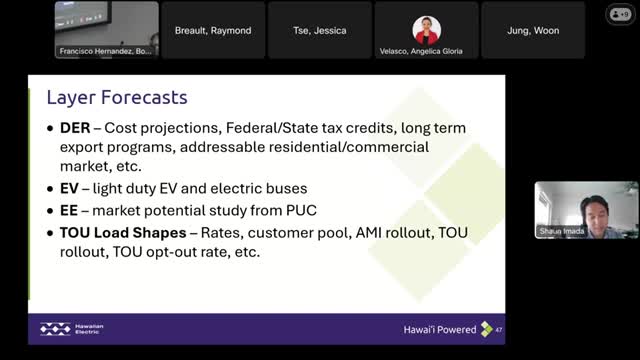Energy Regulators launch detailed analysis of DER hosting capacity in Hawaii
April 24, 2025 | California Public Utilities Commission, Boards and Commissions, Executive, California
This article was created by AI summarizing key points discussed. AI makes mistakes, so for full details and context, please refer to the video of the full meeting. Please report any errors so we can fix them. Report an error »

In a recent workshop held by the California Public Utilities Commission, experts gathered to discuss the future of distributed energy resources (DER) and their implications for the state's energy landscape. The meeting, part of the High DER Proceeding Scenario Planning, focused on critical analyses that will shape California's energy efficiency and hosting capacity strategies.
As the workshop unfolded, participants delved into the methodologies behind forecasting energy needs and assessing the capacity of the grid to accommodate increasing levels of DER. The discussions highlighted a market potential study that served as a foundation for understanding energy efficiency, emphasizing the importance of time-of-use (TOU) rates and customer participation in shaping energy consumption patterns.
The workshop outlined a systematic approach to analyzing hosting capacity, which is essential for integrating renewable energy sources into the grid. The process began with circuit-level forecasts derived from broader system-level data, allowing for a detailed understanding of how much DER could be expected in various scenarios—high, base, and low forecasts.
A significant portion of the analysis involved screening circuits to identify those that could support the anticipated DER without requiring extensive upgrades. This screening process revealed that a small percentage of circuits would need further evaluation to determine if non-infrastructure solutions, such as adjustments to load tap changer settings, could enhance their hosting capacity.
For circuits that did not pass the initial screening, a more sophisticated probabilistic analysis was employed, particularly for areas like Oahu, where data availability allowed for a deeper exploration of potential hosting capacities. This analysis considered various configurations of new photovoltaic installations, assessing their impact on grid stability and capacity.
The findings from this workshop are crucial as California continues to transition towards a more sustainable energy future. With a focus on integrating renewable resources while maintaining grid reliability, the insights gained will inform policy decisions and investment strategies aimed at enhancing the state's energy infrastructure.
As California moves forward, the outcomes of these analyses will play a pivotal role in shaping the state's energy policies, ensuring that the grid can effectively support the growing demand for clean energy solutions. The discussions at the workshop not only reflect the challenges ahead but also the commitment to finding innovative solutions that align with California's ambitious climate goals.
As the workshop unfolded, participants delved into the methodologies behind forecasting energy needs and assessing the capacity of the grid to accommodate increasing levels of DER. The discussions highlighted a market potential study that served as a foundation for understanding energy efficiency, emphasizing the importance of time-of-use (TOU) rates and customer participation in shaping energy consumption patterns.
The workshop outlined a systematic approach to analyzing hosting capacity, which is essential for integrating renewable energy sources into the grid. The process began with circuit-level forecasts derived from broader system-level data, allowing for a detailed understanding of how much DER could be expected in various scenarios—high, base, and low forecasts.
A significant portion of the analysis involved screening circuits to identify those that could support the anticipated DER without requiring extensive upgrades. This screening process revealed that a small percentage of circuits would need further evaluation to determine if non-infrastructure solutions, such as adjustments to load tap changer settings, could enhance their hosting capacity.
For circuits that did not pass the initial screening, a more sophisticated probabilistic analysis was employed, particularly for areas like Oahu, where data availability allowed for a deeper exploration of potential hosting capacities. This analysis considered various configurations of new photovoltaic installations, assessing their impact on grid stability and capacity.
The findings from this workshop are crucial as California continues to transition towards a more sustainable energy future. With a focus on integrating renewable resources while maintaining grid reliability, the insights gained will inform policy decisions and investment strategies aimed at enhancing the state's energy infrastructure.
As California moves forward, the outcomes of these analyses will play a pivotal role in shaping the state's energy policies, ensuring that the grid can effectively support the growing demand for clean energy solutions. The discussions at the workshop not only reflect the challenges ahead but also the commitment to finding innovative solutions that align with California's ambitious climate goals.
View full meeting
This article is based on a recent meeting—watch the full video and explore the complete transcript for deeper insights into the discussion.
View full meeting
